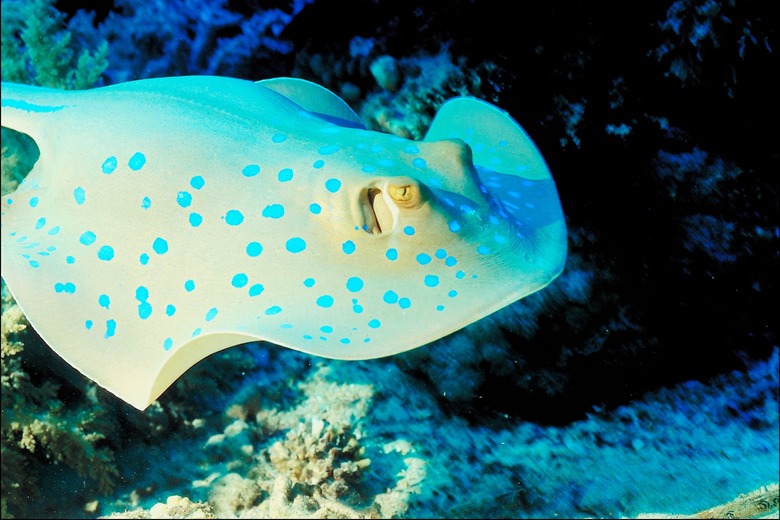How Do Stingrays Take Care Of Their Young?
Stingrays are a type of cartilaginous fish classed in either the Dasyatidae or Urolophidae families. Stingrays have flat bodies with long spines on the end of their tails. They are often found partially buried in the sandy or muddy substrate. Their coloration and patterns vary between species but often mimics their habitat for camouflage.
Read more about the ecosystem of the stringray.
Manta Ray Vs. Stingray
Manta Ray Vs. Stingray
Manta rays are only found in the oceans, while stingrays can be found in both marine and freshwater environments. Manta rays have up to a 23-foot wingspan (7 meters), a lot bigger than the largest stingray species, Himantura polylepis, which has a maximum wingspan of 7.9 meters (2.4 meters).
Manta rays use their wide mouths to feed primarily on zooplankton. Stingrays use their strong jaws to crustaceans, mollusks, worms, small fish and squid.
Read more about the types of stringray fish.
Fun Stingray Facts
Fun Stingray Facts
Stingrays date back on the fossil record to the Jurassic period, 150 million years ago. While stingrays usually live solitary lives, they sometimes meet in groups of up to 10,000 for feeding, called a "fever." Stingrays have small pits in their head called ampullae of Lorenzini which give them an amazing ability to sense through electroreceptors when other animals move .
Stingray Defenses
Stingray Defenses
Stingrays are not considered dangerous animals even though they have the potential to be deadly. They often have timid temperaments and only attack when they feel threatened. Attacking involves them flipping their whip-like tail upwards to stab their victim with the barb on the end of their tail. The barbs on their tails have venomous spines that are capable of killing a human.
The anatomical defenses of electric rays are very similar to stingrays. They differ in that they use electric shocks to defend themselves and capture prey. Electric rays have specialized organs that allow them to deliver shocks of up to 220 volts from their tails, enough to kill a human.
Stingray Reproduction
Stingray Reproduction
Reproduction varies from species to species. Typically stingrays are sexually mature at one year old. Stingrays reproduce through internal fertilization. When they are ready to breed the male will follow the female and bite her disc, enabling him to insert his clasper into her cloaca.
Unlike most fish species which have external fertilization and don't undertake any parental care, stingray mothers keep her eggs safely inside her during development. The mother then gives birth to live young. This type of reproduction is called ovoviviparity.
Difference Between Viviparity and Ovoviviparity
Difference Between Viviparity and Ovoviviparity
Viviparity is when the embryo gets its nutrients directly from the mother. The young are connected to a placenta or placenta-like structure, as in humans. Embryos that develop through ovoviviparity are in an egg, like a chicken, and get their nutrients from the egg. Ovoviviparity is also found in some species of snakes.
Stingray Birth
Stingray Birth
Baby stingrays are called pups. A female, generally speaking, will give birth to five to 13 live pups in a litter. During development, pups are nourished with their yolk sacks. Just before being born, they are nourished with special uterine fluids.
The babies look like mini versions of their parents. Many people have taken stingray videos of them giving birth. In the videos, one can see the young stingrays coming out with their wings somewhat folded and then unfurling when they enter the water.
Juvenile Stingrays
Juvenile Stingrays
Juvenile stingrays are born with the ability to feed and defend themselves. After birth, most juvenile stingrays swim away to start their lives away from their parents. In some species, such as the freshwater whipray (Himantura chaophraya), the mother cares for her young by having them swim with her until they are around one-third of her size. The father stingray does not help care for their young.
References
- Encyclopaedia Britannica: Stingray
- Reference*: What Is the Difference Between a Manta Ray and a Stingray?
- National Geographic: Car-Size Stingray May Be World's Largest Freshwater Fish
- National Geographic Kids: 14 Facts About Stingrays
- Bio Expedition: Stingray
- Zoo Borns: Stingray
- Zoo Borns: Stingray Pups
- Encyclopaedia Britannica: Viviparity
- Encyclopaedia Britannica: Electric Ray
Cite This Article
MLA
Jerrett, Adrianne. "How Do Stingrays Take Care Of Their Young?" sciencing.com, https://www.sciencing.com/do-stingrays-care-young-8791629/. 29 July 2019.
APA
Jerrett, Adrianne. (2019, July 29). How Do Stingrays Take Care Of Their Young?. sciencing.com. Retrieved from https://www.sciencing.com/do-stingrays-care-young-8791629/
Chicago
Jerrett, Adrianne. How Do Stingrays Take Care Of Their Young? last modified August 30, 2022. https://www.sciencing.com/do-stingrays-care-young-8791629/
